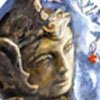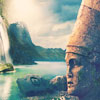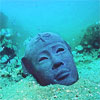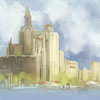Our Story Of Atlantis ~ Part III
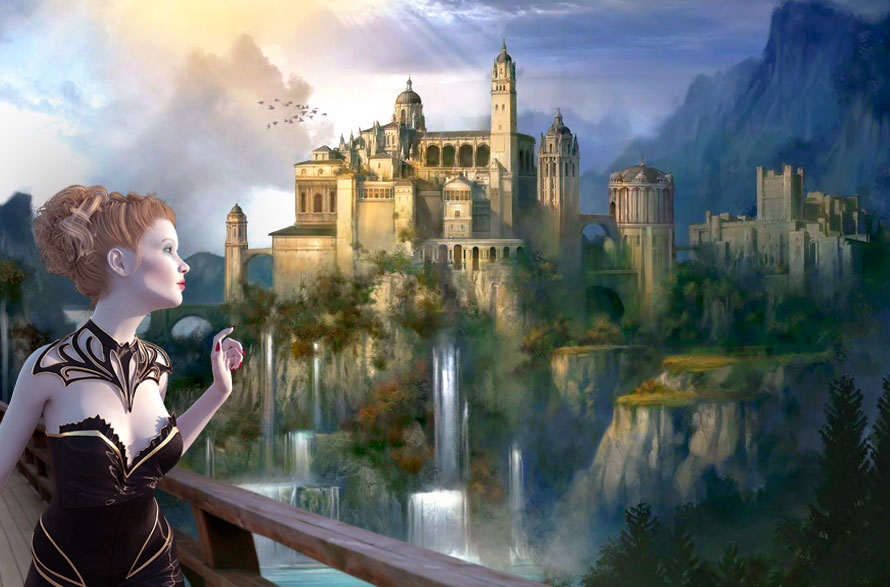 by W. P. Phelon
by W. P. Phelon
To the Northeast of this island Continent is located the Great Temple, built both for use and symbolism. On a plateau of many acres in extent, where the gradually rising ground began to break into the foothills, the whole surface had been leveled and paved with some soft material, of which the Atlantians alone knew the secret. This hardened under the action of the sun and atmosphere, until it was like adamant. To the East, a belt of country reaching to the seacoast, but not on a level with it, had also been smoothed and paved, so that there was no obstruction to the eye, until it rested on the far-off horizon.
Upon this broad expanse of level space, close enough to the mountains to be buttressed by their mighty arms, stood the great, white-walled Temple, facing the South, and the ample areas for assemblage. The closed courts and offices, and the cloisters of the Temple faced the mountains of the North, and thus secured for the Temple Dwellers the privacy needed for the Masters and student Brotherhoods of the Temple, who were seeking to know out of the Silence.
The Temple proper consists of two stories, the first one consisting of pillars springing from the rocky foundations of the mountain and supporting arches, which in turn, held up immense slabs of stone, the floors of the second story. On the first floor there is little or no enclosure, but within the walls of the second story it is all arranged for privacy and quiet thought. He who looks over the battlements of the upper story, looks down about ninety feet, into the beautifully paved court below. On the East and West of the Temple itself, are gardens, groves of trees, fountains, running streams of water, domesticated animals, and flowers of every hue and fragrance. These are sacred to the Temple, but open to the people under the surveillance of the caretakers, except certain reserved spots close to the Temple, which are for the special use of the students and teachers. In the northeast section of the Temple building was the great tower and observatory, fifty feet in diameter, rising 210 feet, a landmark and light extending hundreds of miles and ever a joy-inspirer for the sea-tossed mariners of the State.
Looking from the plaza in front, toward the interior of the Temple, its vast recesses, its forests of white pillars and its high-lifted over-arching roof fills the spectator with awe. Nor was this feeling lessened by the cleanliness, the continuous shifting of huge masses of sunlight and shadow, ever into new and indescribable grotesquerie. During the services the awful solemnity evoked was of a character that modified the whole Atlantian thought and national purpose.
The great tower was commenced fifteen feet below the surface. The original trap rock was supplemented by a square block of concrete rock, and upon this was carried up the superstructure to a total height of 225 feet, the square of fifteen. Upon the floor of the Temple resting on a raised dais was the secret chamber of the Holy of Holies. Across and through this, at High Festivals, blazed and flashed the Veil of Isis. Above, on a level with the upper floor, was the chamber of the Forty-five, and still above that the chambers of the Fifteen, the Seven, the Five and the Three. In the outer, the Tower was smooth and unpenetrated on its surface from bottom to top. It resembled a solid block, chiseled out of quarries and set on end, so deft was the workmanship and so perfect the jointings and finish.
In the cloisters and rooms of the second story of the Temple were the apartments for private study and class instruction. There were also supplemental apartments, hollowed out of the neighboring mountains and reached by secret passages so arranged that whatever should be deposited in them as treasuries would be securely held, even if buried beneath the surface of the sea for ages.
Beyond the great plaza, toward the city, trees and fountains shaded and beautified clear up to the naked edge of the vast pavement.
This is a faint portrayal of that which was really the culmination and concentration of the Nation’s thousands of years of existence and unfolding.
In all our Temples, and more especially in the Great Temple, the outer courts were but the simple separation from those who have no inspiration for the inner and higher. In the outermost court, or court of the people, were always gathered those who had thoughts of their own, and who were undecided as to what direction they should take in pursuit of the light slowly dawning upon them.
The inner court of the people contained those who have so far perceived, that they are willing to obligate themselves to carry out certain purposes, of whose full intent they can know but little, except that the farther end is lost in the light of life, and the halo of obligation. In this court they who seek must be fitted by training and preparation for that which lies before them, so it is natural that they who linger there, striving to advance, must do whatever they can through their own power of assimilation, by themselves.
At the first, if the lesson is concentration, it is their individual concentration. If the lesson is passivity, it is their own individual passivity. It is exactly as when one is learning to sing, as a beginning, the voice is trained to use its own peculiar function alone. After this solitary practice, when some aptitude has been attained and a facility of use, then they are ready for the massing of singles for a united effort. It must follow then, that the outer court of the Brotherhood cannot but lap over into the inner court of the Temple.
That which is done singly and alone, is absolutely necessary for the next step in advance, which is to be made in unison with another or others, in the same way as musical students are trained by twos and fours for united efforts of action and harmony.
The question considered in all this is, how shall growth and attainment be best accomplished? What is the basic principle?
In music we say the sounds are set to a certain key, and however prolonged the action of the vibrations, the key and time will be the same, and all the vibrations are aligned. It is exactly thus, when the students come to act together on the occult planes, the vibrations which they produce will not, of course, be alike, but they must chord; the parts of one vibration fitting and filling in with the vibrations of another, so there shall be no jangle.
To get the best results it is always best that they who are in the outer court of the Brotherhood should be watchful and careful lest the vibrations sent forth from themselves should be hastened or intensified or even drag through the thoughtlessness of their own carelessness.
When once unity of action is attempted in this matter, it is absolutely necessary to success, that the key on which they start should remain the same.
It is easy to see how intense passions, such as anger, or any of the disturbing conditions would interfere with the vibrations. It would be like a chord out of tune in a stringed instrument, where, though the strings do not give out the same sounds, still they must be in alignment. This alignment is the source of all music.
It is not needful that the most intense feelings of one’s nature should be given rein, and allowed to make disturbance, both for himself and those whom he is contracting. It is also, on a small scale, like the sharping and flatting at the wrong points, whereby the vibrations are changed, the harmony broken and discord be comes perceptible.
It is also absolutely necessary that all conditions in the outer which can cause a disturbance should be held in abeyance, when one desires to concentrate, in order that during a united effort for concentration the harmony and strength shall not be marred. This is true of all work on any occult line.
It is not to be supposed when two or more of the Brothers are concentrating, exactly the same process is gone through within the mind of each. That would be impossible. The end sought for can be attained by each working in his own way, with the same thought. It does not follow because A does not perform his task exactly as B does, that B should set up a disturbance in the vibration as reflected from A, thus in a measure destroying the co-operation and effect to be produced.
The law of the Temple then, is first, alone; second, in company with those who are seeking by united force to accomplish, as the Masters of Destiny, at all times, have been able to accomplish. Unity of action is most important, therefore we must guard against anything that can disturb this unity. If vibrations, in their normal conditions lay along side by side, and one is hastened, then the harmony is destroyed and the action of the impulse is to increase the vibrations in the length of their wave force. We must, when meeting for united effort, insist that each for themselves, shall become their own guardians. Knowing that disagreeable things will occur, we must be ever prepared, at once, to put them aside. Having done this once, we shall be stronger to continue. Thus the music from our soul’s action will not only affect ourselves, but those about us.
Upon this statement of principles has been built the great law of the Temple: Do unto others as you would have them do unto you. All the teaching and training, all the ceremonies and symbolism of the Temple are founded upon this law as the corner-stone of the religion of our people. Having given this brief summary of the truths, our priesthood have in charge, let us pass on to a description of some of the ceremonies of the Temple service, and, as an illustration, we will take the Great Feast of the New Year, as more fully including the whole, than any other.
The feast of the New Year, on the 21st of March, consummated and commemorated the Sun’s re-birth, when, out of equal days and nights a new Spring and Summer began for the northern hemisphere, and the promise of seed time and harvest was renewed.
At this celebration it is expected that every family in the kingdom should be present, either personally or represented by some member of the family. All the going and coming of the year is planned with this in view. It is considered a privilege for all the outlying population to be made welcome in the capital at this time. The feast lasts seven days.
Let me attempt to describe at length, for no pen can truly portray all the wonders of that marvelous assemblage, one of the last feasts which took place, ten years before the destruction of the city. The government and people were at that time in their most perfect unity.
About three days before the set date of the feast there could be noticed a little stir of preparation all over the country. It was a quiet movement toward participation. If one had been lifted above, so he could have looked upon the continent as upon a map, there would have been perceived during these three days, long lines of travelers, some on foot, and others by every method of conveyance, moving upon the city in converging lines. As the time grew shorter the extent of these lines grew shorter and the ways close to the city and in the city itself were filled to overflowing. There were but few people in the outlying country who had not some friend or relative in the city proper. When the houses were filled, tents were spread in the gardens, and in all the parks and places of assembly. Thus there was a new appearance given to the light by its reflection from the tents, which were some of linen and some of cotton, but all bleached very white by a process known only to the Atlantians and never imparted to any other nationality. Only on the great plateau of the Temple and the areas of the outer courts, no tents were allowed, for that space was necessarily kept clear, that there might be room for the greater assembly.
As the ceremonies were in commemoration of the new-born sun, the hours of assembly were morning and evening, and at the moment of the meridian height. On the first day of the feast, as the dawn brightened in the East, out of the early twilight, there could be heard throughout the whole city a low, muffled sound like the pouring of a swift torrent through a smooth bed, and as soon as it was light enough to see all the outer courts and the great plateau of the Temple could be perceived, crowded with those who had arrived to take part in the inauguration ceremonies. Their faces were turned toward the East, between whose far horizon and the eyes of the numberless watchers no obstruction intervened.
When the moment approaches for the appearance of the Ruler of the Day, a low, sweet harmony, sounding in rhythmic change, welled out upon the air in slow, restful time and far-reaching tones, from the great Temple choir, who were gathered in one of the porches of the Temple, so raised as to be seen by all the vast multitude. As the sounds of the chant gradually swelled by the voices of the worshipers, became more intense in power and heavier in volume, all the vast multitude seemed to sway, under the psychic spell of this invocation to the Sun; this symbol of welcome to one who returns to his work and purpose. The minutes move quickly on, the invocation is finished, a blast of trumpets accompanying the final note; the orb of day, with tropical suddenness springs from his bed beneath the sea. As his first beams fall upon the countless multitude, they drop upon their knees. With bowed heads, in silent adoration, they ascribe all glory, all power, all praise to that which stands to them as the manifested source of life, of health, of strength, the ever sleepless eye of the One. Then they separate. The hours are spent in social converse, or the abandonment of rest and quiet until it is high noon.
As the Sun approaches the meridian, all the streets and byways, all the housetops, in all places where there may be a worshiper, behold his face turned towards the Temple. At the moment of meridian altitude, above the highest pinnacle, a crystal ball, almost as dazzling in its brilliancy as the sun itself, shoots up, and for a few moments receives the concentrated thought of all the faithful throughout the city, as the reminder of the good messenger of the One, the height of whose glory is now perceived. Again, in the evening there is a convocation at the Temple. The ceremonies of the morning are repeated, with the exception that the song is one of farewell; the multitude facing the West instead of the East, and the hushing sounds of stringed instruments attend his exit from the Western horizon.
These ceremonies are continued for six days. There are various other ceremonies which take up the time of portions of the Convocation, between these assemblies of the whole. There are also lines of Temple services, work and study. Each of the sciences having its appropriate place and each being developed by those who are allied in the great Brotherhood of the Temple. This embraced the whole people in its ramifications. It is not necessary to describe these in all their minutiae. But during these six days there was continually something taking place in the city, always having its moving force at the Temple. The moving of a procession through the streets, a convening of the Temple guides or guards, lectures and talks from those who were so well qualified to give forth from full fountains to the inner souls, eager to be fed. But as the evening draws on after the waning of the sixth day, once more, all the courts of the Temple were thronged. The hum of conversation dies away as the darkness grows more and more intense.
Now, when it shall have become quite dark, the Temple Choir opens the exercises with the song of invocation. It differs from all the music of the Convocation, hitherto, in key, rhythm and time. In this all the people join. As the sound vibrates in swelling cadence, rising and falling amongst the echoing mountains, the effect was perfectly indescribable, for the Atlantians were especially celebrated for being sweet singers. When the singing was finished the chief instructor of the people stood upon a Tribune high raised, and there discoursed of the things which concerned them most intimately in the physical life; of whatever they stood most in need; of how the Sun was to them life and health, and plenty and peace, the sign and representative of all good. Then he directed their attention to the darkness, which sat so uneasily upon them, enforcing rest and inability to work. Then his peroration was after this fashion:
The darkness is death and desolation, and thus, in the beginning, the Existent saw, when he said: ‘Let there be, and there was, light.’ At this word millions of lights gleamed out all over the Temple, inside, outside, even on the highest points. It stood forth one blaze of white marble glory, for there was only one thing about electricity the Atlantians do not know, that is the point where knowledge lays hold with potency upon the One, in its inmost and supreme integrity of existence.
There are other ceremonies of minor importance, pertaining to the night, but this is the most important. There are no sacrifices, no shedding of the blood of animal or human victims. The Atlantians do not believe it is necessary to teach destruction or destructive action by such sacrifice, in the burning or destroying of any living thing, for they say man is naturally destructive and we ought to teach him the opposite. So all our ceremonies lacked the hideous shadow of agony and horror, that will be sure to come if man forgets our teachings. But the great object lessons served well their purpose in elevating the whole people to the same level, and cementing them into a common Brotherhood.
Excerpt from Our Story Of Atlantis
Posted in Atlantis, Other Topics, True History of Manwith comments disabled.


